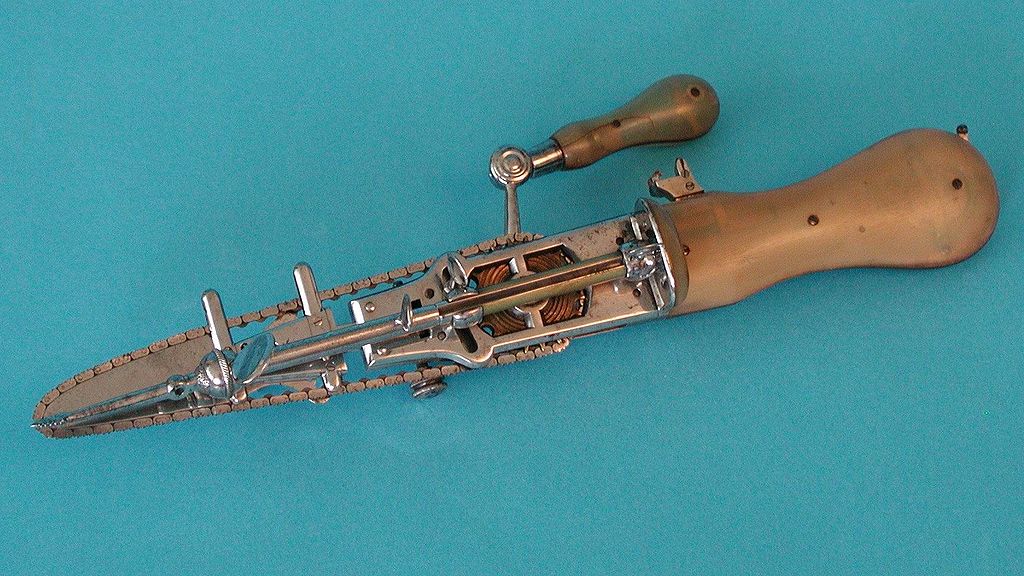

This post has been updated. It was originally published on January 15, 2020.
What’s the weirdest thing you learned this week? Well, whatever it is, we promise you’ll have an even weirder answer if you listen to PopSci’s hit podcast. The Weirdest Thing I Learned This Week hits Apple, Anchor, and everywhere else you listen to podcasts every Wednesday morning. It’s your new favorite source for the strangest science-adjacent facts, figures, and Wikipedia spirals the editors of Popular Science can muster. If you like the stories in this post, we guarantee you’ll love the show.
FACT: The chainsaw was originally developed to aid in difficult childbirths
By Claire Maldarelli
When you picture a chainsaw, the typical uses that come to mind usually have to do with wood (and, you know, chopping it). But why were chainsaws invented, really? It might surprise you that the device’s origin lands about as far away from a lumber yard as you can get: The creators of the chainsaw were two Scottish surgeons named John Aitken and James Jeffray. And they developed their gnarly and dangerous device to help them do their jobs—cutting human bone and flesh.
Even under the best possible circumstances, giving birth is not what most would call a pleasant experience. But in the 18th century, prior to the development of anesthesia and other modern surgical tools, delivery could turn incredibly dangerous with little warning. When babies came out feet-first or their bodies were otherwise trapped in the birth canal, doctors would have to widen the pelvic area by cutting into the cartilage and bone. Aitken and Jeffray found that a sharp knife just didn’t do the trick in a timely fashion, so, somewhat shockingly, they created a chainsaw as a more precise and humane option.
The resulting procedure was known as a symphysiotomy, and thankfully it is no longer in use today. What’s left is the chainsaw, which is now kept well away from surgical wards. Thank goodness.
FACT: You owe your favorite fitness tracker to a man who diligently weighed his own poop
By Rachel Feltman
The next time you finish a workout and glance down at your Apple Watch for instant gratification, thank 16th-century Italian physician Santorio Santorio. He may not have pioneered the practice of counting steps, but he did something even more important to our understanding of self-quantification: He sat down. A lot. For a long time. For the better part of 30 years, in fact.
Santorio dedicated his career to improving our ability to measure important data points, especially as they pertained to health. In a world of physicians who thought you only needed to balance your humors in order to be well, Santorio wanted to know exactly how much phlegm was going into the equation. To that end, he built himself a special balancing chair designed to keep tabs on his weight at all hours.
By weighing himself at multiple points throughout the day—just after waking up; while sitting around doing nothing; before, during, and after eating; after having sex; before and after urinating or defecating—Santorio developed medicine’s first knowledge of the basal metabolic rate. Today we know that most of the calories we need to eat to survive go straight to fueling our organs. Barring seriously strenuous exercise, the calories we burn by moving around are relatively few.
Santorio didn’t have a perfect understanding of this, but his endless weigh-ins did help him land on the basic concept. Why? Because he needed an explanation for his missing poop. Listen to this week’s episode to find out more.
FACT: Some animals seem to have complete control over when they get pregnant
By Sara Chodosh
Pregnancy in general is a whirlwind of experiences in which your body starts doing things it’s never done before—and it can feel a little out of control. But it turns out a lot of animals have a surprising amount of control over their pregnancy. And that starts with choosing when to get preggers in the first place.
I talk a lot in the podcast about why an animal would want to plan when to give birth, but one thing that didn’t make it into the episode is the fact that a number of species can get inseminated while still suckling their babies, then get pregnant after those babies are weaned. A lot of human mothers think that they experience the same thing—that as long as they’re breastfeeding, they can’t conceive again. But that’s a total myth. It’s true that breastfeeding can affect your fertility, and so some women can have unprotected sex without much risk of pregnancy. But it’s also true that plenty of women are absolutely able to get pregnant even while regularly nursing—and that every year, tons of people end up having their second kid earlier than planned because they didn’t realize that fact. So, consider this your fair warning, and check out this week’s episode to hear about the animals who have a way better handle on the whole conception thing than humans do. For more stories about weird animal baby-making, listen to our previous episode about virgin births (yes, they’re a thing).
If you like The Weirdest Thing I Learned This Week, please subscribe, rate, and review us on Apple Podcasts. You can also join in the weirdness in our Facebook group and bedeck yourself in Weirdo merchandise from our Threadless shop.
